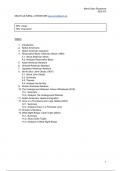María Sanz Rocamora
EEII 810
MULTICULTURAL LITERATURE laura.arce@uam.es
30%: essay
70%: final exam
INDEX
1. Introduction
2. Native Americans
3. Native American Literature
4. Reservation Blues- Sherman Alexie (1995)
4.1. About Sherman Alexie
4.2. Analysis Reservation Blues
5. Asian-American literature
6. Chinese-American literature
7. Japanese-American literature
8. No-No Boy- John Okada (1957)
8.1. About John Okada
8.2. Summary
8.3. Themes
8.4. Analysis No-No Boy
9. African-American literature
10. The Underground Railroad- Colson Whitehead (2016)
10.1. Summary
10.2. Analysis The Underground Railroad
11. Arabic-American/ Jewish immigration
12. Once in a Promised Land- Laila Halaby (2007)
12.1. Summary
12.2. Analysis Once in a Promised Land
13. Chinano’s literature
14. What Night Brings- Carla Trujilo (2003)
14.1. Summary
14.2. About Carla Trujillo
14.3. Analysis of What Night Brings
1
,1. INTRODUCTION
- Modernism: before it there were realism, romanticism and naturalism. The
centre was the author. The description of society, characters, the setting…
Modernism puts focus on language and experiences with it and other arts.
- Postmodernism: it is an extension of Modernism, but goes one step further:
metafiction, talking about the process of writing, authors… The second branch
of Postmodernism (50s- nowadays) is Multiculturalism.
- Multiculturalism: it is linked to the Civil Rights movement. The 60s were
defined by people who started to fight for their rights, to have a place in
society. They started producing pieces of art to express all that. Among all the
ethnic groups producing literature, we can divide them into: Native Amerians
(they suffered an internal colonisation. They were already creating fiction with
myths, legends, stories…), African-American and Chinese-American. The
distinction is that some of them were already there, others were kidnapped
and others willingly went there to live the American Dream. Chicanos for
example were the ones that lived in the North of Mexico but became part of
the USA because they won the war, so the USA let them stay.
- What does it mean to be an American? It is related to the American identity
and the American Dream: WASP (White, Anglo-Saxon, Protestant).
- Colonisers used religious beliefs to create a space for them. They wanted to
exterminate the Native Americans to get all the land for themselves. An
American is more than what they say it was.
- Characters bring up the Constitution but they do not apply it to everyone.
These minorities have never had real access to the American Dream.
- Multiculturalism started in the end of the 19th century but we have a bit of
previous pieces of slaves who wrote their testimonies. A lot of people travelled
there out of political problems in their country or to study.
- In the 19th century the most written pieces were journals and
autobiographies. Until the 60s and the 70s when we started seeing plays,
novels, etc. from 2nd generations of immigrants.
- These 2nd generations were in-between spaces: they were Americans but
they also had to deal with racism problems, the clash between their mother
tongue and that of their ancestors… To explain these issues, D.B. Dubois
created the term Double-consciousness.
- Intersectionality: during the 70s and the 80s minorities started talking about
their gender and sexuality.
2. NATIVE AMERICANS
- They lived in reservations, which are closed communities far away from the
rest of the world.
2
, - When Europeans arrived in America they wanted to believe it was a virgin
land so they could exploit it. It was not virgin and they realised nature was
very different. They needed to occupy the land.
- Native writers are obsessed with rewriting the history white people wrote
about. They manipulated the information to justify their extermination.
America, the virgin land is referred to like a colonised and raped women. They
raped women and destroyed their resources (hunting their animals, blankets
contaminated with viruses, contaminated water…).
- They first arrived in Virginia and then went up, but they were not ready for
winter. The extermination was very difficult. White colonisers realised that
creating wars between clans was useful but not enough.They took them out of
their land to take it, known as relocation.
- In 1830 the Indian Removal Act was approved. It was an authorization for the
military forces to relocate native communities. They separated them (women
and children in one place and men in another one). Family was very important
for them so they separated them so they became slaves and soldiers. If they
fought for the whites they were allowed to have food and see their wives and
kids, but white people wanted their victims’ skulls in exchange. That is why
natives were seen as beasts that ripped skulls, but it was their way of getting
food for their families.
- They had anxiety, depression and were unable to have kids, but they were not
exterminated completely. They were put in reservations. The next step was to
re-educate them. They taught them Catholicism, their language to civilise
them. At the end of the 19th century, colonisers realised that they had to
create boarding schools. Children were separated from their families to forget
their life (language, religion, costumes…). They tried to resist European
assimilation, but that meant isolation and poverty. They live in-between
spaces.
3. NATIVE AMERICAN LITERATURE
- At the beginning (when whites arrived) it was oral, told and shared in a
communal space. Thomas Builds-The-Fire is the one always telling stories
and reminding people about their origins. Myths, legends to understand
nature, their lands… they respected it the most. They were against everything
white people did to the land.
- There was a transition when they started to learn English and to write in
English. They told their stories as autobiographies and journals as kidnapped
kids fighting assimilation. Literature became a space of resistance and
fighting. They used literature as a way of recording the real history.
- Important elements in literature: alcoholism, reservations, resistance and the
Native American Dream/ Nightmare.
3




